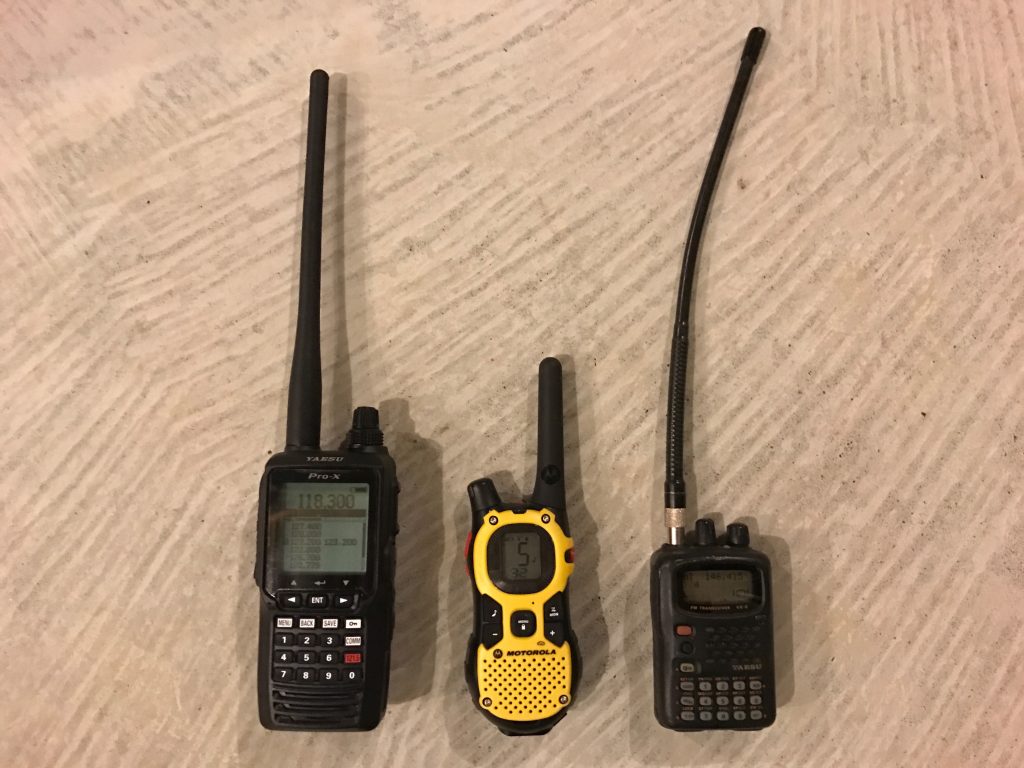Radio Use Information
From your very first flight as a paraglider or hang glider pilot, you have likely been using some kind of radio, either to communicate with your instructor, other pilots, or a ground crew.
How you use the radio depends on where you fly and what kind of radio you are using.
Some background (Radio lingo is quite confusing, so some info below here is intentionally simplified):
The uninformed use of handheld radios can cause a lot of problems. Imagine unintentionally blocking a conversation between RCMP officers in pursuit or between an airplane pilot in trouble and an air traffic controller. Those are not fictitious examples.
This is why the government controls the use of the airwaves. The specific department in charge is called Innovation, Science and Economic Development Canada or DISEDC (Formerly Industry Canada, more info here).
Some frequencies are “free for all”, others are only to be used by specifically licenced radio operators.
In our sport, three types of radios are generally being used. They all operate in different frequency ranges and have different licensing requirements. (In the following, “band” means a range of frequencies grouped together.)

- FM radios; these operate on the 2-METER Amateur band; it is the most common type of radio amongst paraglider and hang glider pilots. Radios that use these frequencies (144 – 148 MHz) are to be used only after obtaining an Amateur Radio Operator Certificate.
- Aircraft Radios; these operate on the Air band (118 – 137 MHz) and are used by commercial and general aviation. Aircraft radios should also be used by hang gliders and paragliders when operating in or near controlled airspace (link to controlled airspace section above). To operate these radios, a Restricted Operator Certificate – Aeronautical (ROC-A) is required.
There are obvious benefits to using Aircraft Radios and sometimes it is mandatory.
- It’ll enable the pilot to communicate with control towers and aircraft pilots in or near controlled airspace. Communicating on the airband is mandatory to enter or operate in some types of airspace such as Control Zones and Mandatory Frequency Areas. The avid cross country pilot will encouter these types of airspace regularly. (See CAR 602.29(2)+(3))
- Air band communications promote safe and collaborative use of the air. This will engender respect from the rest of the aviation community with whom we share the sky.
- FRS radios; this stands for Family Radio Service. You may see this style of radio being used at your school for local operations. No licence is required to operate this type of radio.
DISEDC has set aside two dedicated frequencies that can be used by hang gliders, paragliders and their ground crews for Air to Air and Air to Ground operations. Mind you, a licence to operate on these frequencies is still required. A fee payment may be required as well.
The two dedicated frequencies are:
- 400 MHz on the Air Band for Soaring Purposes
- 640 MHz FM on the private commercial band for Hang Gliding Club Use
Inappropriate use of radios
Many pilots are using radios and/or frequencies for which they are not properly licenced. Even when licenced properly, using FM radios that are intended for ground-to-ground transmissions for Air-to-Ground operations, although not illegal, can cause a lot of interference to others. This is due to the increased range of the radios whilst airborne and thus the possibility of “hitting” repeater stations far away that propagate the transmissions. Using aircraft radios is often more appropriate.
Authorities have approached HPAC in the past over this airborne and unlicensed radio channel use by our pilots!
Also, pilots may be using a particular frequency at their home site without problems, and then continue to use that frequency on road trips without checking to see if that frequency is allocated to another user in other regions or countries, as is often the case. Check with local pilots for the radio do’s and don’ts.
Amateur Radio Operator’s Certificate
All information required to obtain the Amateur Radio Operator’s Certificate to operate an FM radio can be found on this DISEDC web page. You could also check with your local club for sponsored Radio certificate study sessions.
There is no fee required to get the licence itself, but you will have to write an exam and apply for a call sign after you pass. The invigilator will potentially charge for administering the exam.
This certificate is issued for life. You do not need a licence for the radio (station) itself, which used to be the case.
Restricted Operator Certificate – Aeronautical
To operate on an Aircraft radio you need a ROC-A, or a Restricted Operator Certificate – Aeronautical. The ROC-A is issued for life and no revalidation is required.
Here is a link to the official study guide for the ROC-A exam:
http://www.ic.gc.ca/eic/site/smt-gst.nsf/eng/sf01397.html
Testing centres for this exam can be found here, and a frequently asked questions section on the topic is here.